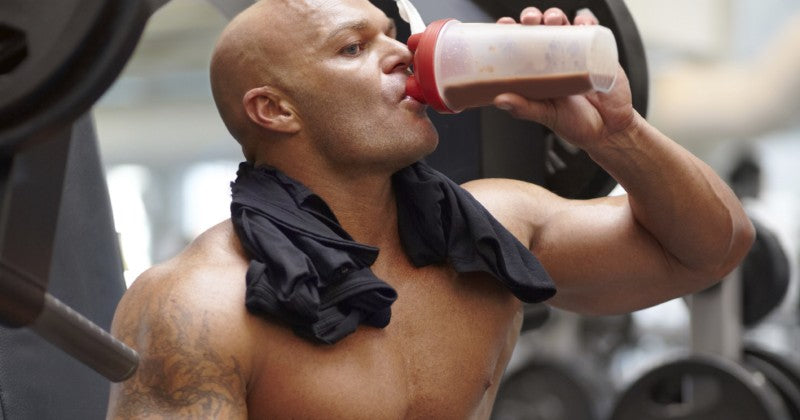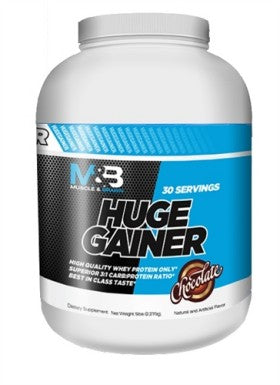you've just finished an intense workout comprised of high-intensity weight lifting and conditioning. You?re drench in sweat and exhausted; as you reach for your post-workout supplement you can't help but wonder if you?re consuming the right balance of carbohydrates and protein.
we've all read about the importance of post-workout nutrition ? carbohydrates to replenish glycogen levels and protein to trigger muscle protein synthesis (MPS). The goal of this article is provide insight on why a 3:1 ratio of carbohydrates to protein is ideal for maximizing recovery from an intense training session.

Muscle & Brawn Huge Gainer is one of the few supplements that contains the ideal 3:1 carb to protein ratio. Order now.
Why a Post-Workout 3:1 Carb to Protein Ratio?
3:1 Carb/Protein Ratio Improves Nutrient Absorption and Muscle Protein Synthesis
Multiple studies support the effectiveness of a 3:1 carbohydrate (CHO) to protein (PRO) ratio. One study found consuming 20-25g of essential amino acids 1 to 3 hours post workout, preferably via whey protein, alongside 60-75g carbohydrates will ensure optimum absorption of both macronutrients as well as maximize muscle protein synthesis (MPS).
[1]
3:1 Carb/Protein Ratio Improves Total Work Output and Recovery Between Interval Sessions
Researchers examined nine male endurance-trained cyclists. They found that those who consumed a 3:1 CHO:PRO beverage between an interval workout and endurance trial to exhaustion at 70% VO2max were able to cycle for a longer of period of time. These cyclists also output more total work compared to those cyclists who only consumed a fluid replacement beverage (re: no carbohydrates or protein, only liquid).
[2]Researchers ran this trial on three separate days and strictly adhered to a 4-hour window between the completion of the first workout and beginning of the second workout.
A separate group of researchers validated the consumption of a 3:1 CHO:PRO beverage between two intensity cycle sessions. Those who consumed a 3:1 CHO:PRO beverage during low-moderate intensity exercise cycled 51% and 43% longer than those who consumed a carbohydrate-only beverage or fluid replacement beverage.
[3]
3:1 Carb/Protein Ratio Rapidly Improves Recovery
A 3:1 CHO:PRO ratio appears to be effective for recovery even when the recovery window is extremely brief. When 13 individuals completed 7 days of baseline training followed by 4 days of increased training duration, those who consumed a 3:1 CHO:PRO beverage had significantly lower creatine kinase blood levels compared to a carbohydrate-only beverage.
[4] Measuring creatine kinase levels provide an indication of muscle inflammation.
[5]We can infer from this study that consuming a 3:1 CHO:PRO beverage decreases muscle inflammation post-workout more effectively than a high carb/no protein beverage.
3:1 Carb/Protein Ratio Stimulates Glycogen Restoration and Reduces Muscle Soreness
The International Society of Sports Nutrition (ISSN) posted two different articles supporting the 3:1 CHO:PRO ratio. In the first article, related to nutrient timing, the ISSN found that consuming 8-10g CHO/kg/day and 0.2g-0.5g PRO/kg/day at a ratio of 3:1 within 30 minutes post-workout can stimulate and maximize muscle glycogen re-synthesis.
[6] When your muscle glycogen is restored you typically feel less sore and perform better during physical activity.
The second article, a comprehensive exercise & sport nutrition review, validate the 3:1 CHO:PRO ratio as a means to ?promote recovery and replenishment of muscle glycogen?.
[7] In this article the ISSN provides the reader with a recommended ratio but not recommend a quantity of protein and carbohydrates.
The Case for Huge Gainer by Muscle and Brawn
[caption id="attachment_12859" align="alignright" width="280"]

Huge Gainer has an optimal 3:1 carb to protein ratio and is the perfect post-workout meal.
Buy now.[/caption]
Muscle & Brawn Huge Gainer is one of the few supplements that contains the ideal 3:1 CHO:PRO ratio.
With 75 grams of carbohydrates and 25 grams of protein per serving, Huge Gainer will improve recovery, replenish glycogen levels, and trigger muscle protein synthesis.
Unlike competitors Huge Gainer tastes great, mixes excellently, uses high quality ingredients, and costs less than $1 per serving. If you?re looking to take your recovery to the next level, Huge Gainer should be a staple in your supplement arsenal.
References
1)"What Should You Eat Before, During, and After Prolonged Training Sessions? - Online Articles: National Council on Strength and Fitness Trainer's Tools." Personal Trainer Certification | Personal Training Certification | NCSF. N.p., n.d. Web. 7 July 2015.2) "Chocolate Milk As a Post-exercise Recovery Aid. - PubMed - NCBI." National Center for Biotechnology Information. N.p., n.d. Web. 7 July 2015.3) "Improved Endurance Capacity Following Chocolate Milk Consumption Compared with 2 Commercially Available Sport Drinks. - PubMed - NCBI." National Center for Biotechnology Information. N.p., n.d. Web. 7 July 2015.4) "Effects of Chocolate Milk Consumption on Markers of Muscle Recovery Following Soccer Training: a Randomized Cross-over Study. - PubMed - NCBI." National Center for Biotechnology Information. N.p., n.d. Web. 7 July 2015.5) "CK: The Test | Creatine Kinase; CK Test: Creatine Kinase; Creatine Phosphokinase; CPK | Lab Tests Online." Blood, Urine & Other Lab Tests Education | Lab Tests Online. N.p., n.d. Web. 7 July 2015.6) "International Society of Sports Nutrition Position Stand: Nutrient Timing. - PubMed - NCBI."National Center for Biotechnology Information. N.p., n.d. Web. 7 July 2015.7) Kreider, Richard B et al. ?ISSN Exercise & Sport Nutrition Review: Research & Recommendations.? Journal of the International Society of Sports Nutrition 7 (2010): 7. PMC. Web.



 Huge Gainer has an optimal 3:1 carb to protein ratio and is the perfect post-workout meal. Buy now.[/caption]
Huge Gainer has an optimal 3:1 carb to protein ratio and is the perfect post-workout meal. Buy now.[/caption]